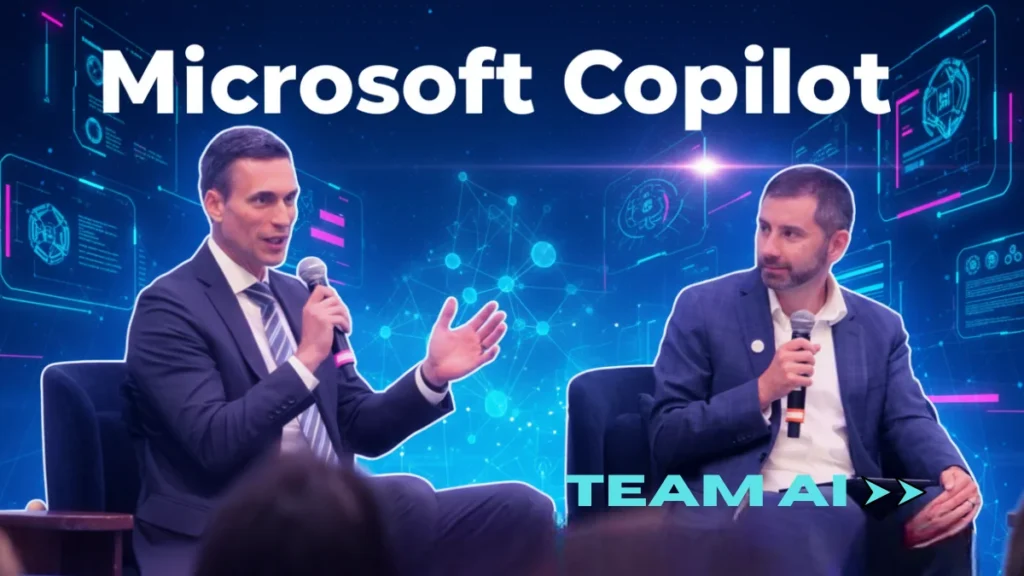Microsoft is preparing to make AI less of a solo tool and more of a shared workspace.
At the Microsoft Alumni Network Connect 2025 conference, Jared Spataro, the company’s AI-at-Work chief, said Copilot will soon let groups collaborate with each other — and with AI — in real time.
Key Takeaways
- Microsoft signals shift from solo AI use to shared collaboration.
- Copilot’s “team sport” features expected to roll out this fall.
- New tools could reshape workplace roles and career development.
- Microsoft bets collaboration will fuel viral adoption, like Teams.
- Competitors Google, Slack, and Zoom also eye AI collaboration.
Microsoft’s Jared Spataro revealed that Copilot is set to move beyond individual productivity, enabling group collaboration with AI. Dubbed a “team sport,” the shift builds on Copilot Pages and could redefine how teams share, edit, and create together — positioning Microsoft against rivals like Google and Slack.
Microsoft’s Next Big Copilot Move
Microsoft is doubling down on a future where artificial intelligence isn’t just a personal assistant but a collaborative teammate. Speaking Tuesday at the Microsoft Alumni Network Connect 2025 conference, Jared Spataro, the company’s Chief Marketing Officer for AI at Work, outlined how the next phase of Copilot will push AI into group settings.
“So far, AI-based work has been kind of a solo sport,” Spataro said. “This fall it will clearly become a team sport, where you’ll be working together with other people and AI.”
The remarks suggest Microsoft will soon expand beyond Copilot Pages — introduced last year as a shared workspace for “multiplayer AI collaboration” — into broader, enterprise-wide use cases.
Why Microsoft Sees Collaboration as the Next Frontier
The idea of “AI as a team sport” taps into a familiar growth playbook. Spataro compared it to the viral rise of Microsoft Teams during the pandemic, when adoption spread through users sending each other meeting invites.
In his view, once collaboration features enter daily workflows, they’ll spread faster than traditional software licenses. And with competitors like Google, Slack, Zoom, and a host of AI startups rolling out their own team-focused agents, Microsoft is under pressure to stay ahead.
AI’s Impact on Jobs and Skills
Spataro also made a striking claim: AI is collapsing the traditional boundaries between job roles. With “the marginal cost of expertise” dropping close to zero, workers are taking on tasks once considered outside their skillset.
He cited LinkedIn data showing designers writing more code than ever before, thanks to AI. “In the past, building software required specialists across design, front-end, and back-end,” he said. “AI is enabling more people to be full-stack.”
The shift, he argued, may reverse centuries of labor specialization dating back to Adam Smith’s economic theories. “That would be the unleashing of human ingenuity that’s been locked up because the economy has become uber-specialized,” Spataro said.
Rethinking Career Development
Another key theme was career growth in the age of Copilot. Spataro noted that seasoned professionals often get the most out of AI tools, because they can better judge outputs.
Some companies, he said, are now reviving apprenticeship models — pairing experienced staff with juniors — to help newcomers learn not just AI prompts but judgment and context.
The ROI Question
Spataro admitted he once thought Microsoft 365 Copilot’s $30 per user per month pricing was a no-brainer. But he later learned personal productivity gains are hard to quantify.
The true value, he said, comes at the organizational level — in process improvements and operating-cost reductions, sometimes in the hundreds of millions.
Copilot as a Thought Partner
One of the most telling anecdotes came from Spataro’s own team. While working with Harvard on a research project, they used Copilot, powered by GPT-5, to help generate polished prose and resolve disagreements.
“For the first time, we felt like we could have gone out to an agency and we wouldn’t have gotten better,” Spataro said. Instead of replacing employees, the AI acted as a thought partner — pushing the work forward.
The New “Frontier Firm”
Looking ahead, Spataro described a new kind of business model: human-led, agent-operated organizations. In these “frontier firms,” people set vision and strategy while AI agents execute much of the work.
He outlined three patterns Microsoft is monitoring:
- Humans working with assistants.
- Humans teaming with agents.
- Agents managing other agents.
“Humans still play an incredibly important role,” Spataro said. “But as much as possible, agents are operating a lot of what happens.”
Pandemic as Catalyst
Spataro also argued the pandemic set the stage for today’s AI surge. The rapid adoption of digital communication and collaboration created the data pipelines and habits that Copilot now builds upon.
“We don’t believe that we could have the world of AI that we have today without the pandemic that we had yesterday,” he said.
Conclusion
Microsoft is betting the next big leap for AI isn’t smarter assistants but smarter collaboration. By making Copilot a “team sport,” the company hopes to spark viral adoption while positioning itself ahead of rivals.
Whether workers embrace AI teammates with the same speed as they once embraced Teams will be one of the most important tests of Microsoft’s AI era.
